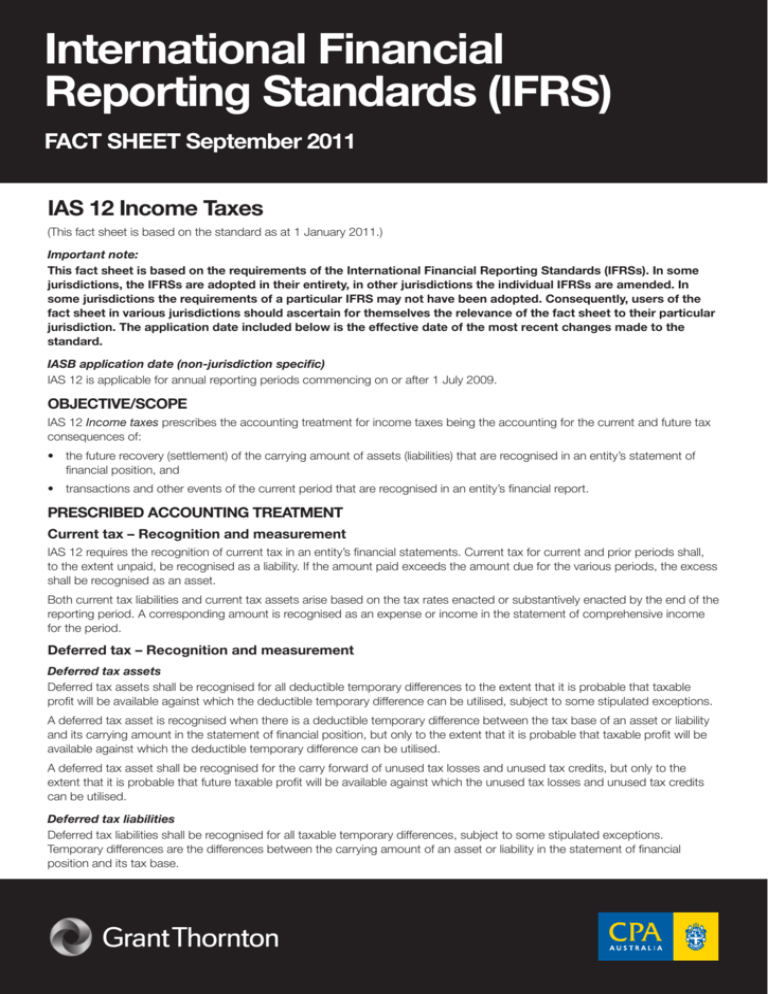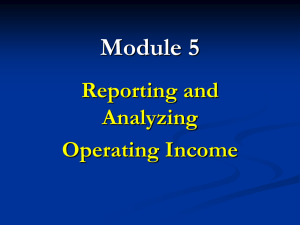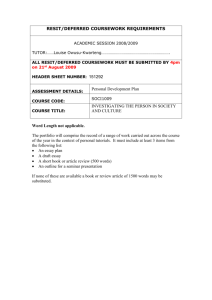
International Financial
Reporting Standards (IFRS)
FACT SHEET September 2011
IAS 12 Income Taxes
(This fact sheet is based on the standard as at 1 January 2011.)
Important note:
This fact sheet is based on the requirements of the International Financial Reporting Standards (IFRSs). In some
jurisdictions, the IFRSs are adopted in their entirety, in other jurisdictions the individual IFRSs are amended. In
some jurisdictions the requirements of a particular IFRS may not have been adopted. Consequently, users of the
fact sheet in various jurisdictions should ascertain for themselves the relevance of the fact sheet to their particular
jurisdiction. The application date included below is the effective date of the most recent changes made to the
standard.
IASB application date (non-jurisdiction specific)
IAS 12 is applicable for annual reporting periods commencing on or after 1 July 2009.
Objective/scope
IAS 12 Income taxes prescribes the accounting treatment for income taxes being the accounting for the current and future tax
consequences of:
• the future recovery (settlement) of the carrying amount of assets (liabilities) that are recognised in an entity’s statement of
financial position, and
• transactions and other events of the current period that are recognised in an entity’s financial report.
Prescribed accounting treatment
Current tax – Recognition and measurement
IAS 12 requires the recognition of current tax in an entity’s financial statements. Current tax for current and prior periods shall,
to the extent unpaid, be recognised as a liability. If the amount paid exceeds the amount due for the various periods, the excess
shall be recognised as an asset.
Both current tax liabilities and current tax assets arise based on the tax rates enacted or substantively enacted by the end of the
reporting period. A corresponding amount is recognised as an expense or income in the statement of comprehensive income
for the period.
Deferred tax – Recognition and measurement
Deferred tax assets
Deferred tax assets shall be recognised for all deductible temporary differences to the extent that it is probable that taxable
profit will be available against which the deductible temporary difference can be utilised, subject to some stipulated exceptions.
A deferred tax asset is recognised when there is a deductible temporary difference between the tax base of an asset or liability
and its carrying amount in the statement of financial position, but only to the extent that it is probable that taxable profit will be
available against which the deductible temporary difference can be utilised.
A deferred tax asset shall be recognised for the carry forward of unused tax losses and unused tax credits, but only to the
extent that it is probable that future taxable profit will be available against which the unused tax losses and unused tax credits
can be utilised.
Deferred tax liabilities
Deferred tax liabilities shall be recognised for all taxable temporary differences, subject to some stipulated exceptions.
Temporary differences are the differences between the carrying amount of an asset or liability in the statement of financial
position and its tax base.
International Financial
Reporting Standards (IFRS)
A deferred tax liability shall be recognised when there is a taxable temporary difference between the tax base of an asset or
liability and its corresponding carrying amount in the statement of financial position. This arises when the carrying amount of an
asset exceeds its tax base. Consequently, the future recovery of the carrying amount will generate taxable profit; e.g:
• accumulated depreciation of an asset in the financial statements is less than the cumulative depreciation allowed up to the
reporting date for tax purposes, e.g. depreciation of an asset is accelerated for tax purposes;
• development costs have been capitalised and will be amortised to the statement of comprehensive income but were
deducted in calculating taxable amounts in the reporting period in which they were incurred.
A taxable temporary difference also arises when the carrying amount of a liability is less than its tax base, because the future
settlement of its tax base will generate taxable profit (e.g. a loan initially recognised at fair value net of borrowing costs incurred
in the loan establishment but the tax deductions for the costs are amortised over the life of the loan).
A deferred tax liability will not be recognised if arising from:
• the initial recognition of goodwill or goodwill which amortisation is not deductible for tax purposes
• the initial recognition of an asset or liability in a transaction which is not a business combination, and, at the time of the
transaction, effects neither accounting profit nor taxable profit (tax loss).
Measurement of deferred tax assets and liabilities
A deferred tax asset or liability shall be measured based on the enacted, or substantively enacted, tax rates (tax laws) expected
to apply when the asset is realised or the liability is settled, and is recognised as an income or expense, and included in profit
or loss for the period. An exception arises when the item is credited or charged directly to other comprehensive income (e.g.
the revaluation of property, plant and equipment, or an adjustment to the opening balance of retained earnings due to a change
in accounting policy or an error correction), in which case the amount of deferred tax liability or asset is charged or credited
directly to other comprehensive income.
Deferred tax assets and liabilities are not discounted.
Summary
A summary of the IAS 12 deferred tax requirements is shown below:
Accounting for Assets
Accounting for Liabilities
Note: * refers to the present tax rate or tax laws (tax rates) that have been enacted or substantively enacted by the end of the
reporting period.
2
International Financial
Reporting Standards (IFRS)
PRESENTATION
Current tax assets and liabilities are offset if, and only if, the entity:
a) has a legally enforceable right to set-off the recognised amounts; and
b) intends either to settle on a net basis, or to realise the asset and settle the liability simultaneously.
Deferred tax assets and liabilities are offset if, and only if, the entity:
a) has a legally enforceable right to set-off current tax assets against current tax liabilities; and
b) the deferred tax assets and the deferred tax liabilities relate to income taxes levied by the same taxation authorities on either:
• the same taxable entity; or
• different taxable entities which intend either to settle current tax liabilities and assets on a net basis, or to realise the
assets and settle the liabilities simultaneously, in each future period in which significant amounts of deferred tax liabilities
or assets are expected to be settled or recovered.
Disclosures
Refer Appendix 1 for a checklist to assist with IAS 12 disclosure requirements.
Important definitions
Accounting profit
profit or loss for a period before deducting tax expense.
Current tax
the amount of income taxes payable (recoverable) in respect of the taxable profit (tax loss) for
a period.
Deferred tax assets
the amounts of income taxes recoverable in future periods in respect of:
• deductible temporary differences
• the carryforward of unused tax losses
• the carryforward of unused tax credits.
Deferred tax liabilities
the amounts of income taxes payable in future periods in respect of taxable temporary
differences.
Taxable profit (tax loss)
the profit (loss) for a period, determined in accordance with the rules established by the
taxation authorities, upon which income taxes are payable (recoverable).
Tax base
of an asset or liability is the amount attributed to that asset or liability for tax purposes.
Tax expense (tax income)
the aggregate amount included in the determination of profit or loss for the period in respect
of current tax and deferred tax.
Temporary differences
differences between the carrying amount of an asset or liability in the statement of financial
position and its tax base.
Temporary differences may be either:
• taxable temporary differences, which are temporary differences that will result in taxable
amounts in determining taxable profit (tax loss) of future periods when the carrying amount
of the asset or liability is recovered or settled
• deductible temporary differences, which are temporary differences that will result in
amounts that are deductible in determining taxable profit (tax loss) of future periods when
the carrying amount of the asset or liability is recovered or settled.
Australian specific requirements
The Australian equivalent standard is AASB 112 which is applicable for annual reporting periods beginning on or after 1 January
2011.
Scope
For public sector entities and for the purpose of AASB 112 Income taxes also include forms of income tax that may be payable
by a public sector entity under their own enabling legislation or other authority. These forms of income tax are often referred to
as ‘income tax equivalents’.
3
International Financial
Reporting Standards (IFRS)
Appendix 1 – Disclosure checklist
This checklist can be used to review your financial statements – you should complete the Yes / No / N/A column about whether
the requirement is included and provide an explanation for No answers to ensure the completeness of disclosures.
Yes / No /
N/A
Explanation
(if required)
IAS 12: Income Taxes – Applicable for financial statement periods beginning on or after 1 July 2009.
IAS 12.79
Are the following major components of tax expense (income) disclosed
separately:
a) current tax expense (income);
b) any adjustments recognised in the period for current tax of prior periods;
c) the amount of deferred tax expense (income) relating to the origination and
reversal of temporary differences;
d) the amount of deferred tax expense (income) relating to changes in tax
rates or the imposition of new taxes;
e) the amount of the benefit arising from a previously unrecognised tax loss,
tax credit or temporary difference of a prior period that is used to reduce
current tax expense;
f) the amount of the benefit from a previously unrecognised tax loss, tax
credit or temporary difference of a prior period that is used to reduce
deferred tax expense;
g) deferred tax expense arising from the write-down, or reversal of a previous
write-down, of a deferred tax asset where it is no longer probable that
sufficient taxable profit will be available to allow the benefit of part or all of
that deferred tax asset to be utilised (see IAS 12.56); and
h) the amount of tax expense (income) relating to those changes in
accounting policies and errors that are included in profit or loss
in accordance with IAS 8, because they cannot be accounted for
retrospectively.
Note: These are examples only and there may be other components requiring
disclosure.
IAS 12.81
Has the following information been disclosed separately:
a) the aggregate current and deferred tax relating to items that are charged
or credited directly to equity (see paragraph 62A);
b) the amount of income tax relating to each component of other
comprehensive income (see paragraph 62 and IAS 1 (as revised in 2007));
c) an explanation of the relationship between tax expense (income) and
accounting profit or loss in the following forms:
i. a numerical reconciliation between tax expense (income) and the result
of accounting profit multiplied by the applicable tax rate(s), disclosing
also the basis on which the applicable tax rate(s) is (are) computed;
ii. a numerical reconciliation between the average effective tax rate
and the applicable tax rate, disclosing also the basis on which the
applicable tax rate is computed;
d) an explanation of changes in the applicable tax rate(s) compared to the
previous reporting period;
4
International Financial
Reporting Standards (IFRS)
Yes / No /
N/A
Explanation
(if required)
e) the amount and expiry date (if any) relating to deductible temporary
differences, unused tax losses, and unused tax credits for which no
deferred tax asset is recognised in the Statement of Financial Position;
f) the aggregate amount of temporary differences associated with
investments in subsidiaries, branches and associates and interests in joint
ventures, for which deferred tax liabilities have not been recognised (see
IAS 12.39 for additional guidance);
g) for each type of temporary difference, and for each type of unused tax
losses and unused tax credits:
i. the amount of the deferred tax assets and liabilities recognised in the
Statement of Financial Position for each period presented;
ii. the amount of the deferred tax income or expense recognised in
profit or loss, if this is not apparent from the changes in the amounts
recognised in the Statement of Financial Position
h) for discontinued operations, the tax expense relating to:
i. the gain or loss on discontinuance; and
ii. the profit or loss from the discontinuing operation for the period,
together with the corresponding amounts for each prior period
presented; and
i) the amount of income tax consequences of dividends to shareholders of
the entity that were proposed or declared before the financial statements
were authorised for issue, but are not recognised as a liability in the
financial statements.
j) if a business combination in which the entity is the acquirer causes a
change in the amount recognised for its pre-acquisition deferred tax asset
(see paragraph 67), the amount of that change; and
k) if the deferred tax benefits acquired in a business combination are not
recognised at the acquisition date but are recognised after the acquisition
date (see paragraph 68), a description of the event or change in
circumstances that caused the deferred tax benefits to be recognised.
IAS 12.82
Has the following information been disclosed when:
1. the utilisation of the deferred tax asset is dependent on future taxable
profits in excess of the profits arising from the reversal of existing taxable
temporary differences, and
2. the entity has suffered a loss in either the current or preceding period in
the tax jurisdiction to which the deferred tax asset relates:
a) the amount of a deferred tax asset; and
b) the nature of the evidence supporting its recognition.
5
International Financial
Reporting Standards (IFRS)
Yes / No /
N/A
IAS 12.82A
Explanation
(if required)
In the circumstances described below taken from IAS 12.52A apply, has
the entity disclosed the nature of the potential income tax consequences
that would result from the payment of dividends to its shareholders. In
addition, has the entity disclosed the amounts of the potential income tax
consequences practicably determinable and whether there are any potential
income tax consequences not practicably determinable.
Taken from IAS 12.52A ‘In some jurisdictions, income taxes are payable at a
higher or lower rate if part or all of the net profit or retained earnings is paid
out as a dividend to shareholders of the entity. In some other jurisdictions,
income taxes may be refundable or payable if part or all of the net profit
or retained earnings is paid out as a dividend to shareholders of the entity.
In these circumstances, current and deferred tax assets and liabilities are
measured at the tax rate applicable to undistributed profits’.
IAS 12.87
Has the entity disclosed the aggregate amount of underlying temporary
differences?
IAS 12.87
Has the amount of unrecognised deferred tax liabilities associated with
investments in subsidiaries, branches and associates and interests in joint
ventures, for which deferred tax liabilities have not been recognised, been
disclosed when this disclosure does not require undue cost or effort?
Note this disclosure is encouraged but not mandatory.
IAS 12.88
Has the entity disclosed any tax-related contingent liabilities and contingent
assets in accordance with IAS 37 Provisions, Contingent Liabilities and
Contingent Assets?
Note this disclosure is encouraged but not mandatory.
6
OTHER MATTERS
Legal Notice
Copyright © CPA Australia Ltd (ABN 64 008 392 452), 2011. All rights reserved. Save and except for direct quotes from the International Financial
Reporting Standards (IFRS) and accompanying documents issued by the International Accounting Standards Board (IASB) (“IFRS Copyright”), all
content in these materials is owned by or licensed to CPA Australia. The use of IFRS Copyright in these materials is in accordance with the IASB’s Terms
and Conditions. All trade marks and trade names are proprietary to CPA Australia and must not be downloaded, reproduced or otherwise used without
the express consent of CPA Australia. You may access and display these pages on your computer, monitor or other video display device and make one
printed copy of any whole page or pages for personal and professional non-commercial purposes only. You must not (i) reproduce the whole or part of
these materials to provide to anyone else; and/or (ii) use these materials to create a commercial product or to distribute them for commercial gain.
Disclaimer
CPA Australia has used reasonable care and skill in compiling the content of these materials. However, CPA Australia makes no warranty as to the
accuracy or completeness of any information contained therein nor does CPA Australia accept responsibility for any acts or omissions in reliance upon
these materials.
These materials are; (i) intended to be a guide only and no part of these materials are intended to be advice, whether legal or professional; (ii) not a
complete representation of the Standard referred to and/or quoted and consequently are no substitute for reading the latest and complete standards.
All individuals are advised to seek professional advice to keep abreast of reforms and developments, whether legal or regulatory.
Limitation of Liability
To the extent permitted by applicable law, CPA Australia, its employees, agents and consultants exclude all liability for any loss or damage claims and
expenses including but not limited to legal costs, indirect special or consequential loss or damage (including but not limited to, negligence) arising out of
the information in the materials. Where any law prohibits the exclusion of such liability, CPA Australia limits its liability to the re-supply of the information.





